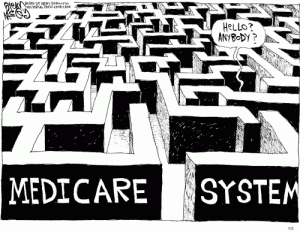By Jack Cumming
The biggest objection senior housing salespeople encounter is said to be, “We’re not ready for that yet.” The standard industry response is that you’re better off moving in sooner rather than later. Despite that industry assertion, I was surprised after I moved into a CCRC in 2006 to discover that almost no senior housing executives move in themselves. They, too, say, “We’re not ready for that yet.”
Are You Ready for Senior Living?
Why, it now occurs to me, doesn’t the industry change that? Why not offer options that work for people where they are along life’s journey so that they affiliate with senior housing long before they absolutely need it and are then finally “ready for that?” There’s a huge unmet need that the industry just ignores. In fact, it’s generally ignored. It’s an opportunity just waiting for someone with some gumption to respond to.
When people reach age 60 or thereabouts — or even sooner, their 40s and 50s — they often start thinking about life after a productive career. They may already want to reduce the stresses of daily living. After years of living in a single-family home, it can become tiresome to have to cope with clogged toilets, water leaks, meal preparation, and the myriad chores of everyday life. Senior housing is good at alleviating these chores and stresses.
Rebranding With Substance
Taking advantage of this opportunity would require rebranding, but then senior housing could benefit from rebranding. After all, who wants to be known for having moved into a home for the aged? The industry tried semantic rebranding a few years ago, but that has not worked except in the imaginations of those who promote it. “Life plan community”? What’s that? Oh, it’s a CCRC. Why didn’t you just say so? It’s a place for people who are ready for that because they need health care. It’s a facility.
Obviously, anyone anticipating the freedom years that follow employment will be more attracted to a club-like environment than to a place designed to ameliorate decline, frailty, befuddlement, and irrelevance. Clubs can vary from the local VFW to Ritz-Carlton elegance. Even now, active adult 55+ living is growing in popularity as CCRC institutionalization is experiencing resistance.
Help People to Stay Put
Developing an offering that supports people where they are would bring people into connection with better living without have to actually move in. That alternative can be very attractive for someone who has just given up a job and now has more freedom. Freedom can be intimidating until a person decides whether they want a life of golf or a life of business formation and mentorship, with a full range of possibilities in between.
Extending services beyond the walls of a CCRC is a natural step to take to add revenues to an otherwise constrained residential undertaking. This can be done by offering memberships that give access to community amenities to those who “aren’t ready for that yet.”
Some communities already offer such connections. It’s easiest to begin by opening a paid membership program to those who are on the waiting list. Also, there need be no age constraint. Younger people can bring vibrancy to underutilized, stagnant public spaces in a CCRC. It can avoid the stigma that residents are all over-the-hill and irrelevant.
A Stressful Transition
Transitioning into aging is one of the most difficult life changes to navigate, and the senior living industry is well-positioned to help meet those needs. To accommodate such an opportunity, it would be wise to rethink the concepts of continuing life. For instance, a wellness emphasis is more attractive than health care. An appeal to active living is more enticing than emphasizing “you can age in your residence” as you deteriorate.
Also, although CCRCs offer many amenities, coworking spaces are almost never part of that package. Adding support for lifelong productivity should be part of any initiative to improve senior living. The vitality and longevity revolution makes aging a happy, purposeful life stage. That calls for new thinking. Many prospective residents now plan to live to 100 and beyond and expect to stay active throughout. A coworking space was something I hoped to find 18 years ago. It’s even more desirable today.
Is a CCRC a Wise Choice?
Facilitating a gradual, progressive transition into aging can transform today’s approaches to aging. The big question is whether this generation of senior living leaders (CEOs/developers/financers) will be the first to transform the offering so that it is one that they choose for themselves. If those who control what the offering is don’t choose it, then the remaining question is whether anyone should.








